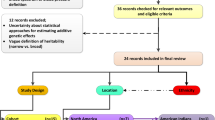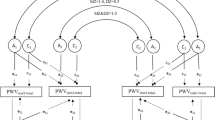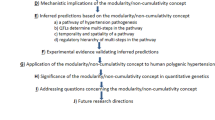Abstract
Blood pressure (BP) reactivity to orthostatic tilt may be predictive of cardiovascular disease. However, the genetic and environmental influences on BP reactivity to tilt have not been well examined. Identifying different influences on BP at rest and BP during tilt is complicated by the intercorrelation among multiple measurements. In this study, we use principal components analysis (PCA) to reduce multivariate BP data into components that are orthogonal. The objective of this study is to characterize and examine the genetic architecture of BP at rest and during head-up tilt (HUT). Specifically, we estimate the heritability of individual BP measures and three principal components (PC) derived from multiple BP measurements during HUT. Additionally, we estimate covariate effects on these traits. The study sample consisted of 444 individuals, distributed across four large families. HUT consisted of 70° head-up table tilting while strapped to a tilt table. BP reactivity (ΔBP) was defined as BP during HUT minus BP while supine. Three PC extracted from the PCA were interpreted as ‘general BP’ (PC1), ‘pulse pressure’ (PC2) and ‘BP reactivity’ (PC3). Variance components methods were used to estimate the heritabilities of resting BP, HUT BP, ΔBP, as well as the three BP PC. Significant (P<0.05) heritabilities were found for all BP measurements, except for systolic ΔBP at 1 and 3 min, and diastolic ΔBP at 2 min. Significant genetic effects were also found for the three PC. Each of these orthogonal components is significantly influenced by somewhat different sets of covariates.
This is a preview of subscription content, access via your institution
Access options
Subscribe to this journal
Receive 12 digital issues and online access to articles
$119.00 per year
only $9.92 per issue
Buy this article
- Purchase on Springer Link
- Instant access to full article PDF
Prices may be subject to local taxes which are calculated during checkout

Similar content being viewed by others
References
Kral BG, Becker LC, Blumenthal RS, Aversano T, Fleisher LA, Yook RM et al. Exaggerated reactivity to mental stress is associated with exercise-induced myocardial ischemia in an asymptomatic high-risk population. Circulation 1997; 96: 4246–4253.
Kamarck TW, Everson SA, Kaplan GA, Manuck SB, Jennings JR, Salonen R et al. Exaggerated blood pressure responses during mental stress are associated with enhanced carotid atherosclerosis in middle-aged Finnish men: findings from the Kuopio Ischemic Heart Disease Study. Circulation 1997; 96: 3842–3848.
Nardo CJ, Chambless LE, Light KC, Rosamond WD, Sharrett AR, Tell GS et al. Descriptive epidemiology of blood pressure response to change in body position. The ARIC study. Hypertension 1999; 33: 1123–1129.
Rose KM, Tyroler HA, Nardo CJ, Arnett DK, Light KC, Rosamond W et al. Orthostatic hypotension and the incidence of coronary heart disease: the Atherosclerosis Risk in Communities study. Am J Hypertens 2000; 13 (Part 1): 571–578.
Eigenbrodt ML, Rose KM, Couper DJ, Arnett DK, Smith R, Jones D . Orthostatic hypotension as a risk factor for stroke: the atherosclerosis risk in communities (ARIC) study, 1987–1996. Stroke 2000; 31: 2307–2313.
Knox SS, Hausdorff J, Markovitz JH . Reactivity as a predictor of subsequent blood pressure: racial differences in the Coronary Artery Risk Development in Young Adults (CARDIA) Study. Hypertension 2002; 40: 914–919.
Kasagi F, Akahoshi M, Shimaoka K . Relation between cold pressor test and development of hypertension based on 28-year follow-up. Hypertension 1995; 25: 71–76.
Rose KM, Holme I, Light KC, Sharrett AR, Tyroler HA, Heiss G . Association between the blood pressure response to a change in posture and the 6-year incidence of hypertension: prospective findings from the ARIC study. J Hum Hypertens 2002; 16: 771–777.
Thomas CB, Duszynski KR . Blood pressure levels in young adulthood as predictors of hypertension and the fate of the cold pressor test. Johns Hopkins Med J 1982; 151: 93–100.
Carroll D, Davey Smith G, Sheffield D, Willemsen G, Sweetnam PM, Gallacher JE et al. Blood pressure reactions to the cold pressor test and the prediction of future blood pressure status: data from the Caerphilly study. J Hum Hypertens 1996; 10: 777–780.
Light KC . Hypertension and the reactivity hypothesis: the next generation. Psychosom Med 2001; 63: 744–746.
Light KC, Girdler SS, Sherwood A, Bragdon EE, Brownley KA, West SG et al. High stress responsivity predicts later blood pressure only in combination with positive family history and high life stress. Hypertension 1999; 33: 1458–1464.
Pankow JS, Rose KM, Oberman A, Hunt SC, Atwood LD, Djoussé L et al. Possible locus on chromosome 18q influencing postural systolic blood pressure changes. Hypertension 2000; 36: 471–476.
North KE, Rose KM, Borecki IB, Oberman A, Hunt SC, Miller MB et al. Evidence for a gene on chromosome 13 influencing postural systolic blood pressure change and body mass index. Hypertension 2004; 43: 780–784.
Harrap SB, Cui JS, Wong ZY, Hopper JL . Familial and genomic analyses of postural changes in systolic and diastolic blood pressure. Hypertension 2004; 43: 586–591.
Manly BFJ . Multivariate Statistical Methods: A Primer, 2nd edn. Chapman & Hall: London, 1994.
Siervogel RM, Frey MA, Kezdi P, Roche AF, Stanley EL . Blood pressure, electrolytes, and body size: their relationships in young relatives of men with essential hypertension. Hypertension 1980; 2 (Part 2): 83–92.
Choh AC, Czerwinski SA, Lee M, Demerath EW, Wilson AF, Towne B et al. Quantitative genetic analysis of blood pressure response during the cold pressor test. Am J Hypertens 2005; 18: 1211–1217.
Collins R, Winkleby MA . African American women and men at high and low risk for hypertension: a signal detection analysis of NHANES III, 1988–1994. Prev Med 2002; 35: 303–312.
Lohman TG, Roche AF, Martorell R . Anthropometric Standardization Reference Manual. Human Kinetics Books: Champaign, IL, 1988.
Kachigan SK . Multivariate Statistical Analysis: A Conceptual Introduction, 2nd edn. Radius Press: New York, 1991.
Tabachnick BG, Fidell LS . Using Multivariate Statistics, 3rd edn. Harper Collins College Publishers: New York, NY, 1996.
Stevens J . Applied Multivariate Statistics for the Social Sciences, 4th edn. Lawrence Erlbaum Associates: Mahwah, NJ, 2002.
Almasy L, Blangero J . Multipoint quantitative trait linkage analysis in general pedigrees. Am J Hum Genet 1998; 62: 1198–1211.
Edwards AWF . Likelihood, expanded edn. Johns Hopkins University Press: Baltimore, MD, 1992.
Chobanian AV, Bakris GL, Black HR, Cushman WC, Green LA, Izzo Jr JL et al. The Seventh Report of the Joint National Committee on Prevention, Detection, Evaluation, and Treatment of High Blood Pressure: the JNC 7 report. J Am Med Assoc 2003; 289: 2560–2572.
Schatz IJ, Bannister R, Freeman RL, Goetz CG, Jankovic J, Kaufmann HC et al. Consensus statement on the definition of orthostatic hypotension, pure autonomic failure, and multiple system atrophy. Neurology 1996; 46: 1470.
Kario K, Eguchi K, Hoshide S, Hoshide Y, Umeda Y, Mitsuhashi T et al. U-curve relationship between orthostatic blood pressure change and silent cerebrovascular disease in elderly hypertensives: orthostatic hypertension as a new cardiovascular risk factor. J Am Coll Cardiol 2002; 40: 133–141.
Streeten DH, Auchincloss Jr JH, Anderson Jr GH, Richardson RL, Thomas FD, Miller JW . Orthostatic hypertension. Pathogenetic studies. Hypertension 1985; 7: 196–203.
Hsueh WC, Mitchell BD, Aburomia R, Pollin T, Sakul H, Gelder Ehm M et al. Diabetes in the Old Order Amish: characterization and heritability analysis of the Amish Family Diabetes Study. Diabetes Care 2000; 23: 595–601.
Knuiman MW, Divitini ML, Welborn TA, Bartholomew HC . Familial correlations, cohabitation effects, and heritability for cardiovascular risk factors. Ann Epidemiol 1996; 6: 188–194.
Levy D, DeStefano AL, Larson MG, O'Donnell CJ, Lifton RP, Gavras H et al. Evidence for a gene influencing blood pressure on chromosome 17. Genome scan linkage results for longitudinal blood pressure phenotypes in subjects from the Framingham Heart study. Hypertension 2000; 36: 477–483.
North KE, Howard BV, Welty TK, Best LG, Lee ET, Yeh JL et al. Genetic and environmental contributions to cardiovascular disease risk in American Indians: the Strong Heart Family Study. Am J Epidemiol 2003; 157: 303–314.
Rotimi CN, Cooper RS, Cao G, Ogunbiyi O, Ladipo M, Owoaje E et al. Maximum-likelihood generalized heritability estimate for blood pressure in Nigerian families. Hypertension 1999; 33: 874–878.
Watanabe RM, Valle T, Hauser ER, Ghosh S, Eriksson J, Kohtamaki K et al. Familiality of quantitative metabolic traits in Finnish families with non-insulin-dependent diabetes mellitus. Finland–United States Investigation of NIDDM Genetics (FUSION) Study investigators. Hum Hered 1999; 49: 159–168.
Choh AC, Gage TB, McGarvey ST, Comuzzie AG . Genetic and environmental correlations between various anthropometric and blood pressure traits among adult Samoans. Am J Phys Anthropol 2001; 115: 304–311.
Mitchell BD, Kammerer CM, Mahaney MC, Blangero J, Comuzzie AG, Atwood LD et al. Genetic analysis of the IRS. Pleiotropic effects of genes influencing insulin levels on lipoprotein and obesity measures. Arterioscler Thromb Vasc Biol 1996; 16: 281–288.
Gu C, Borecki I, Gagnon J, Bouchard C, Leon AS, Skinner JS et al. Familial resemblance for resting blood pressure with particular reference to racial differences: preliminary analyses from the HERITAGE Family Study. Hum Biol 1998; 70: 77–90.
Majumder PP, Das RN, Nayak S, Bhattacharya SK, Mukherjee BN . Genetic epidemiology of blood pressure in two Indian populations: some lessons. Hum Biol 1995; 67: 827–842.
Pérusse L, Rice T, Bouchard C, Vogler GP, Rao DC . Cardiovascular risk factors in a French–Canadian population: resolution of genetic and familial environmental effects on blood pressure by using extensive information on environmental correlates. Am J Hum Genet 1989; 45: 240–251.
Mitchell BD, Kammerer CM, Blangero J, Mahaney MC, Rainwater DL, Dyke B et al. Genetic and environmental contributions to cardiovascular risk factors in Mexican Americans. The San Antonio Family Heart Study. Circulation 1996; 94: 2159–2170.
Hunt SC, Hasstedt SJ, Kuida H, Stults BM, Hopkins PN, Williams RR . Genetic heritability and common environmental components of resting and stressed blood pressures, lipids, and body mass index in Utah pedigrees and twins. Am J Epidemiol 1989; 129: 625–638.
Rose KM, North K, Arnett DK, Ellison RC, Hunt SC, Lewis CE et al. Blood pressure and pulse responses to three stressors: associations with sociodemographic characteristics and cardiovascular risk factors. J Hum Hypertens 2004; 18: 333–341.
Acknowledgements
This work was supported by NIH/NHLBI Grants (R01-HL69995, R01-HL070167) and an American Heart Association Ohio Valley Affiliate Postdoctoral Fellowship Grant (0325371B) to ACC.
Author information
Authors and Affiliations
Corresponding author
Rights and permissions
About this article
Cite this article
Choh, A., Czerwinski, S., Lee, M. et al. Quantitative genetic analysis of blood pressure reactivity to orthostatic tilt using principal components analysis. J Hum Hypertens 20, 281–289 (2006). https://doi.org/10.1038/sj.jhh.1001975
Received:
Revised:
Accepted:
Published:
Issue Date:
DOI: https://doi.org/10.1038/sj.jhh.1001975



